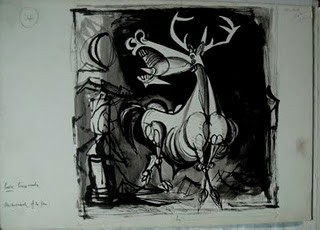Friday, January 06, 2012
Some Family Photos
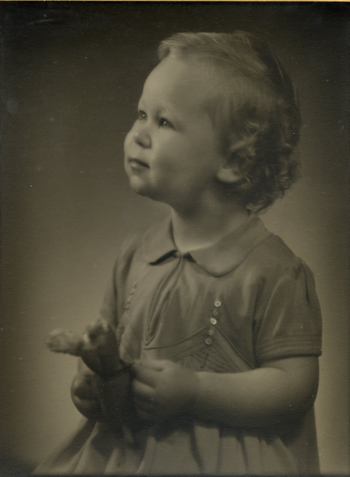
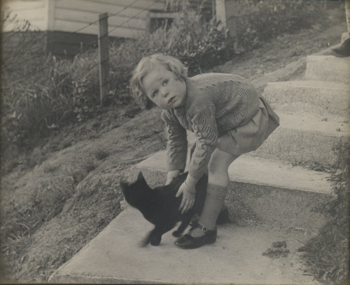

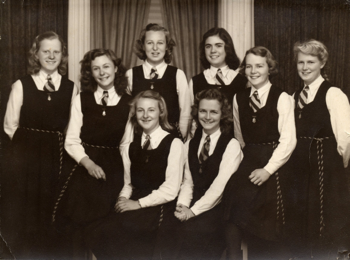
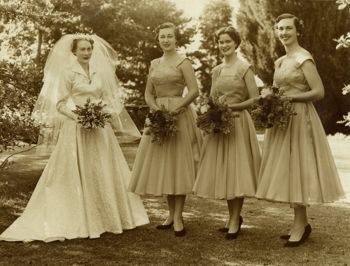
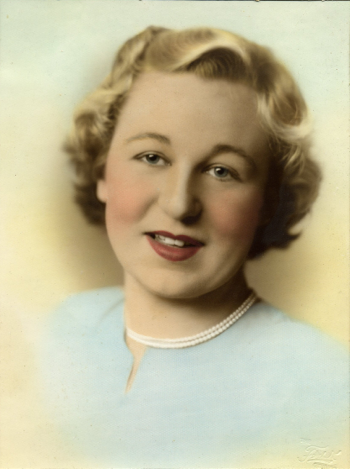
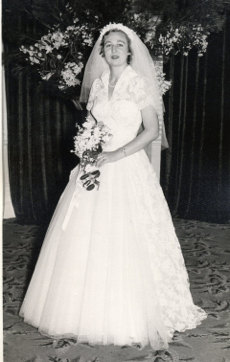
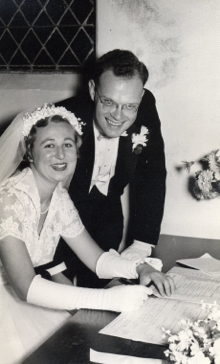
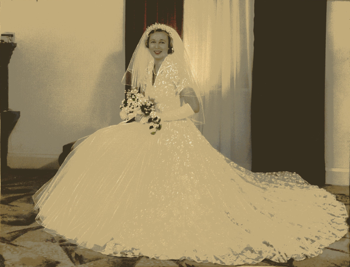
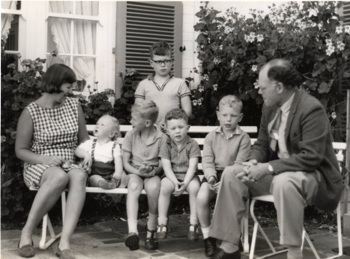
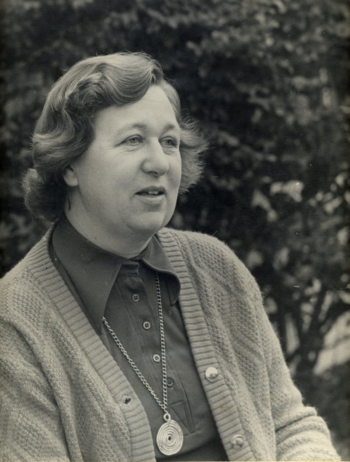



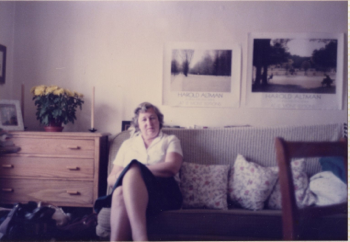
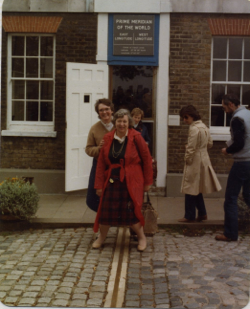

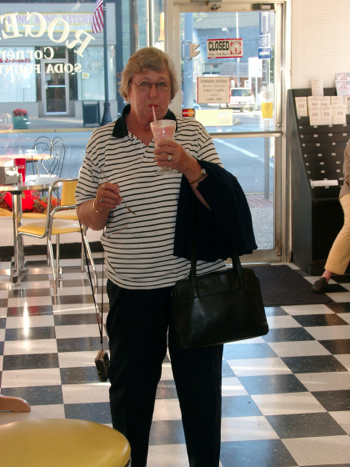
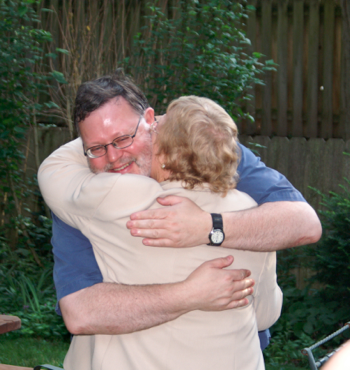
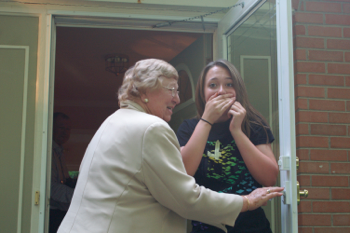

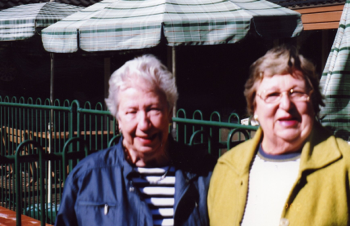
Thursday, January 05, 2012
War and Violence in the Work of Ronald Searle (1920-2011)
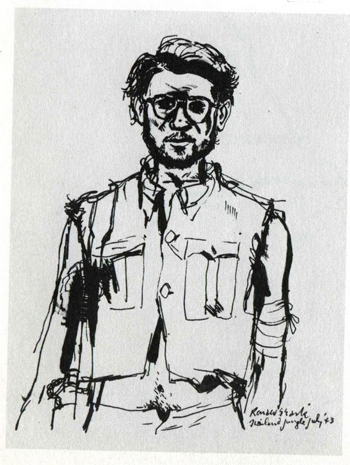
[Self Portrait in Thai Jungle July 1943]
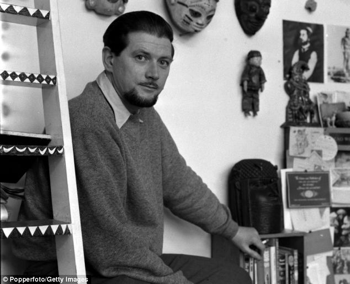
[Searle in 1954]
The English cartoonist and illustrator Ronald Searle died on 31 December 2011. He is unfortunately best remembered for his drawings about the fictional British public school for girls "St. Trinians" which he conceived while a captive of the Japanese during WW2. He regretted the fame and typecasting which came from this early success and moved to Paris then the south of France in order to concentrate on his book illustrations and cartoons. Many of the following illustrations come from the collection in the Imperial War Museum or Perpetua - Ronald Searle Tribute <http://ronaldsearle.blogspot.com/>
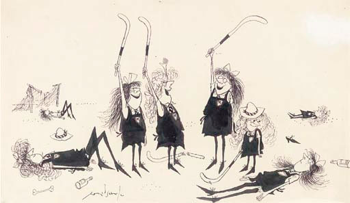
[Victory on the Hockey Field] [See a larger version of this image]
I came across the other side of his work when I read his book To the Kwai - and Back: War Drawings, 1939-1945 (Collins and Imperial War Museum, 1986) when I was researching the art which emerged from the POW and concentration camps of WW2. His collection of eyewitness drawings of life in Changi Prison in Singapore and the work camps of the notorious Thai-Burma railway is extraordinary. He secretly documented his experiences and hid them from his guards by placing them under the mattresses of soldiers who were dying from cholera. The brutality and disregard for human life which he experienced first hand led him to ask himself the question - "could this happen to people in my home country, or is this something peculiar to the Japanese people and their culture?" His answer seems to be that it is a universal phenomenon.
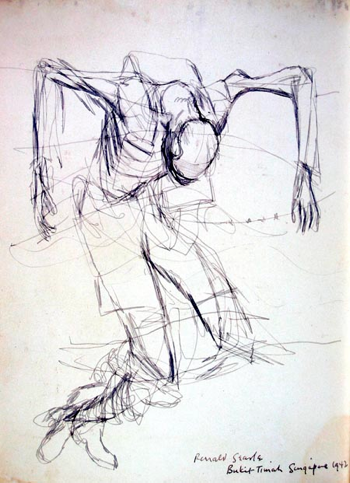
[Dead man on barbed wire fence, Singapore 1942] [See a larger version of this image]
His stroke of genius was to imagine a typical English private school for girls where the girls behaved in a violent manner towards their peers and their teachers. Behind the apparently humorous hijinks of the girls was a darker view of human nature in which violence, torture, and moral collapse was the order of the day. Searle did his first cartoons of the girls of St. Trinians while he was a prisoner and sold them to magazines upon his return to civilian life. They subsequently appeared in books and then as films and made him a fortune.
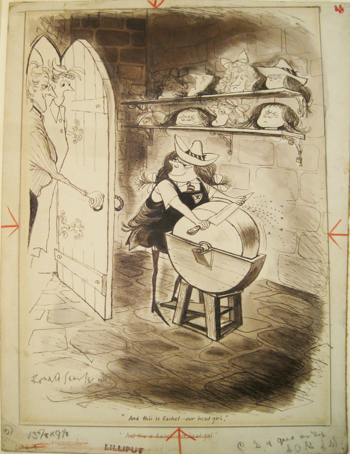
[The "Head Girl" Rachel] [See a larger version of this image]
After his move to Paris in 1961 Searle was very successful with his work on magazine covers, cartoons, book illustrations and other art work. I have selected a number of works which illustrate his interest in the military and the political events of his day. He explicitly acknowledged the influence of people like Francisco Goya, Honoré Daumier, George Grosz, and Pablo Picasso, all of who were also "political" in one way or another.
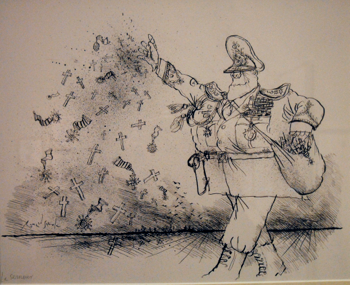
[A cartoon from Le Monde - "The Sower"] [See a larger version of this image]
The following pictures come from "To the Kwai and Back":
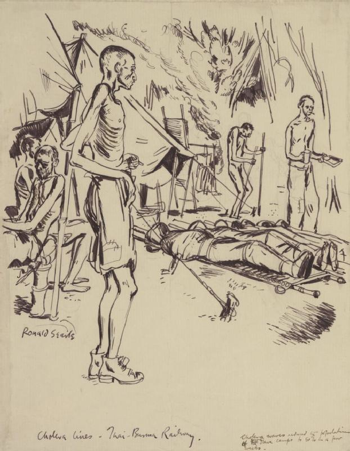
["Cholera Lines" 1943] [See a larger version of this image]
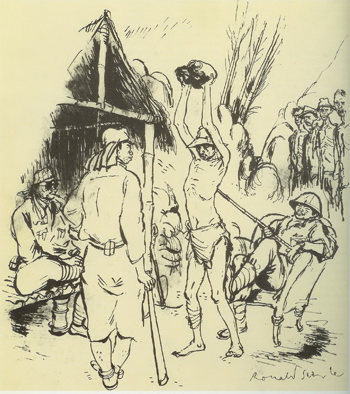
[Torturing prisoners for Fun at Lunch Time 1943] [See a larger version of this image]
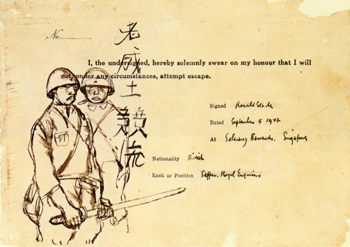
[Prisoners were forced to sign an oath of obedience] [See a larger version of this image]
Here are some more images about St. Trinians girl school. A "battle cry" was written for the girls which goes as follows:
Maidens of St Trinian's, gird your armour on.
Grab the nearest weapon; never
mind which one.
The battle's to the strongest; might is always right.
Trample on the weakest;
glory in their plight.
St Trinian's! St Trinian's! Our battle cry.
St Trinian's! St Trinian's! Will
never die.
Stride towards your fortune boldly on your way,
Never once forgetting there's
one born every day.
Let our motto be broadcast: "get your blow in first!"
She who draws
the sword last always comes off worst.
The large drawing below of "The Fall of St. Trinians" is a veritable battle painting in the style of the 17th century French engraver Jacques Callot who meticulously documented the battles and guerrilla fighting of the Thirty Years War, such as "The Siege of Breda".
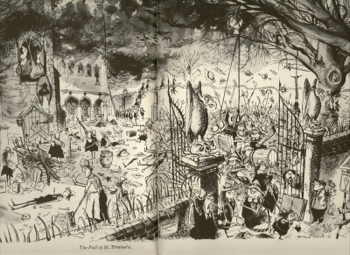
[The Fall of St. Trinians] [See a larger version of this image]
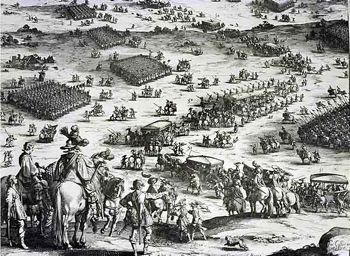
[Detail from Jacques Callot, "The Siege of Breda" (1628)] [See a larger version of this image]
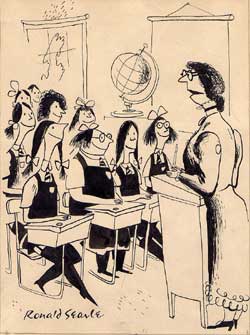
[The teacher asks the girls who set fire to the East Wing, 1944]
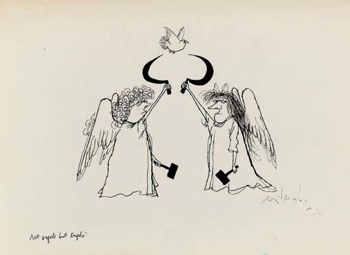
["Not Angles but Engels"] [See a larger version of this image]
Robert Graves wrote a "School Hymn for St. Trinians" which was illustrated by Searle:
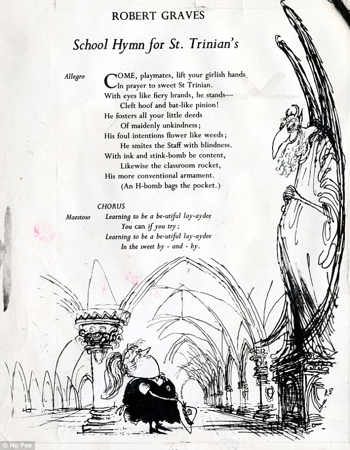
[See a larger version of this image]
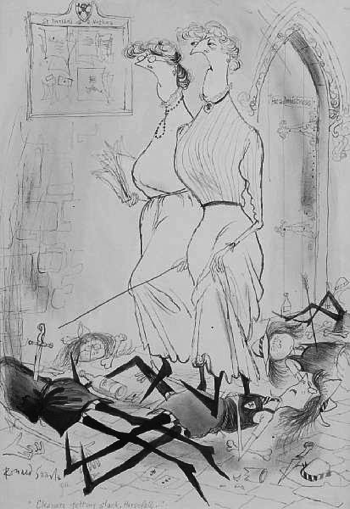
[Teachers complaining about the failure of the cleaners to keep the corridors clean] [See a larger version of this image]
[See Part II for further discussion]
War and Violence in the Work of Ronald Searle (1920-2011) Part II
[See Part I of this essay on Searle]
Here are some other cartoons and illustrations which deal with political and military issues:
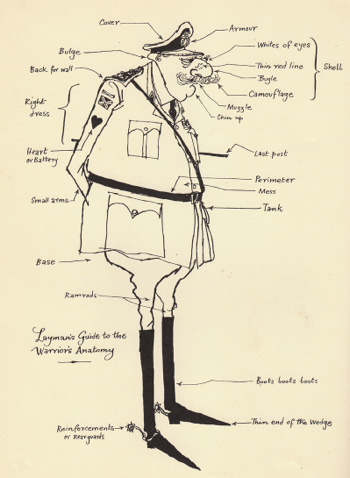
[The Anatomy of a Warrior] [See a larger version of this image]
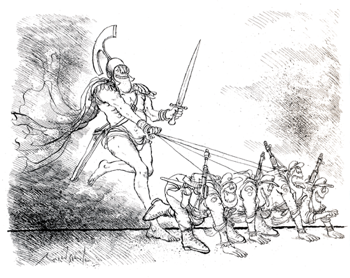
["Mercenaries"] [See a larger version of this image]
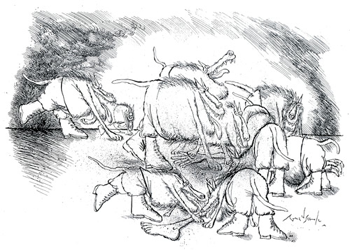
[Ethnic Cleansing] [See a larger version of this image]
The image below is very much in the style of Honoré Daumier's bitter cartoons of the German Wars of Unification during the 1860s, especially "Peace Idyll".
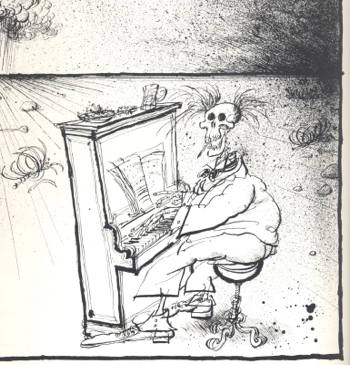
[After the Atomic Apocalypse] [See a larger version of this image]
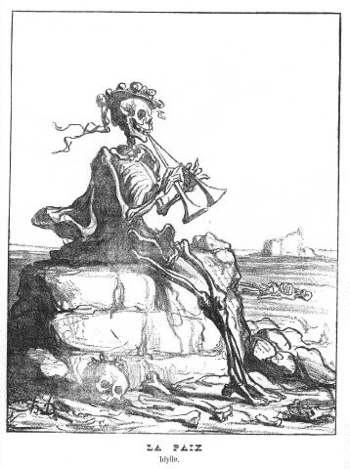
[Daumier, "Peace Idyll"]
Here are some miscellaneous pictures which I found interesting and/or amusing:
[A drawing of a deer in the style of Picasso's horse in Guernica]
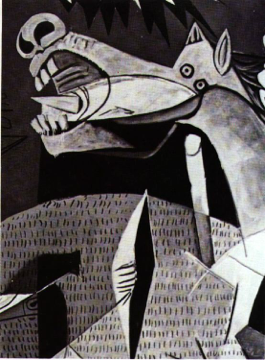
[Wounded Horse from Picasso's "Guernica" (1937)]

[London: Revolt in Trafalgar Square, 1964] [See a larger version of this image]
The image below is the reverse of the Scandinavian idea of the Yule Goat which takes from the children at Christmas. Here the children hijack Santa and seize the toys themselves. See this post.
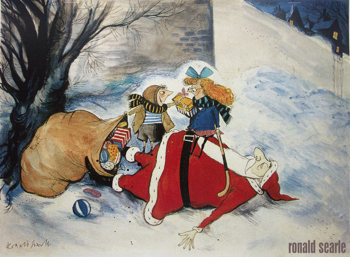
[Robbing Santa: "This one is for you, this one for me"] [See a larger version of this image]
Sunday, January 01, 2012
Tyrants in the Arab World
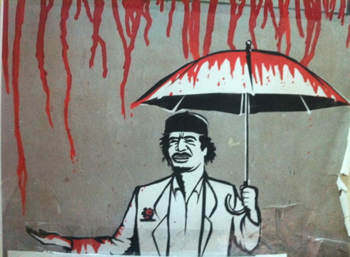
I came across an interesting manifesto against Arab tyrants. It was mentioned by The Guardian journalist of the Middle East Robert Fisk who, in an end of year article, asks why middle eastern tyrants lasted so long. He mentions a very clever "Arab Tyrants Manual" which was compiled on Twitter over a period of time as events were unfolding after March 2011. People would send in their observations in Tweet form on how tyrants tried to stay in power. It is funny, clever, and rather sad. The original is here and I have I put a version of it on my own website here. along with an extract of an introductory chapter to the work which is not yet complete. It should be of considerable interest to libertarians - note that the author quotes Lord Acton's famous remark about how power corrupts.
Also note that the item 5th from the end says "Demonstrate your confidence with a casual prop of some kind. Umbrellas are good." which reminded me of this anti-Gaddafi wall graffiti which appeared during the uprising. There was also a strange photograph of him sitting in his car giving a talk on Libyan TV while holding an umbrella.
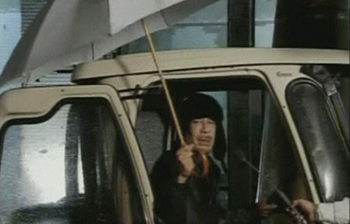
The eye patch as a symbol of resistance in Egypt
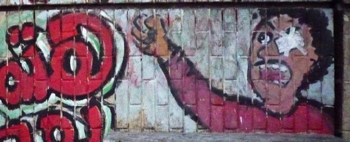
The use of snipers in Libya, Egypt, Syria, and Yemen to shoot unarmed protesters who are resisting their oppressive regimes has been a feature of the uprisings across the Middle East in 2011. In Egypt the snipers who were shooting at protesters in Tahrir Square in Cairo specialized in shooting people in the head, especially the eyes. One report in The Guardian newspaper claimed over 80 people had been shot in the eye since the uprising began in January. Perhaps because the protesters were beginning to see clearly the nature of their oppressors and the need to overthrow them; perhaps because the regime wanted to return the people to a state of blindness and ignorance; or perhaps the snipers were just malicious thugs - who knows exactly why they targeted the eyes.
Some of the injured returned to protesting wearing white eye patches to protect their injuries and this quickly became a symbol of the resistance. Famous statues around the square (of a popular singer and the lion guarding the square at the Qasr al-Nil bridge) were outfitted with eye patches. Wall graffiti of the injured were painted and photographed by supporters of the revolt.
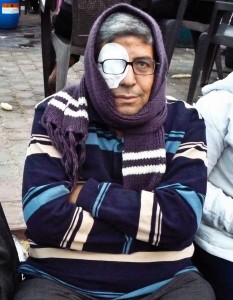
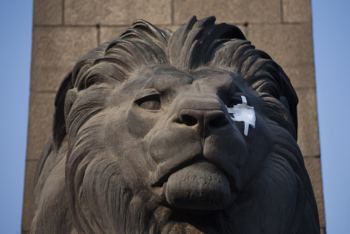
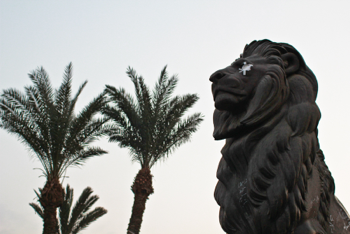
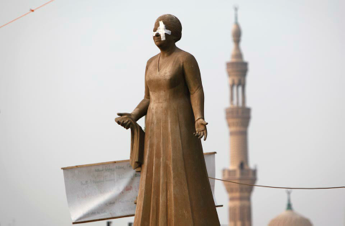
Here are some more examples:
[Below] "Protesters take a nap beneath graffiti with two eye patches symbolizing protesters wounded during recent clashes between police and demonstrators, at a protest encampment in front of the cabinet building in Cairo, Egypt Sunday, Dec. 11, 2011. An Egyptian Cabinet led by newly appointed prime minister Kamal el-Ganzouri was sworn in last Wednesday amid continuing calls for the ruling military council and its interim government to step down. The Arabic writing reads, "slap him in the face and tell the liars that his cheek is rose.""
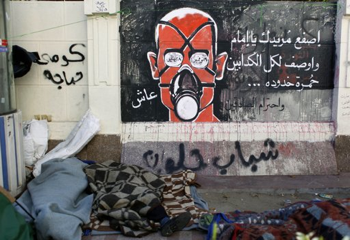
Another piece of wall grafiitti:
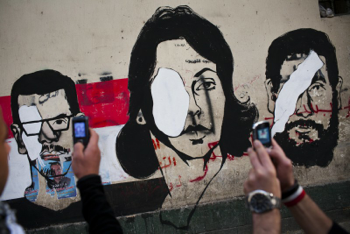
The white eye patch has became the symbol of the victim of state terror in Egypt. It also is the symbol of the perpetrator of this terror and is deeply linked to a long tradition in western culture of one eyed monsters who kill or eat the flesh of humans. In Egypt, wall graffiti of those responsible for these policies and also of one of the more feared snipers who was supposed to have been particularly expert at shooting people in the eyes also appeared. One in particular has been mentioned in reports, Mahmoud Sobhi El Shinawi, who is a CSF (Central Security Forces) officer who has been nicknamed the "Eye Hunter". In graffiti he has been depicted wearing a blood red eye patch as a symbol of his crimes. See below:
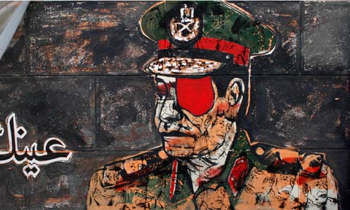
The one eyed killer of men reminds one of the ancient Greek giants the Cyclopes who create from their forges the weapons of Zeus (thunderbolts), Hades (helmet), and Poseidon (trident).
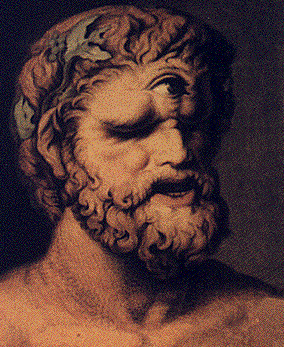
[Johann Heinrich Wilhelm Tischbein, "Polyphemus" (1802) (Landesmuseum Oldenburg)]
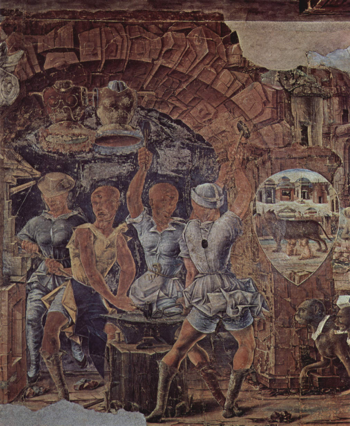
[Cosimo Tura (c.1430 – 1495), "September: The Workshop of Vulkan" (Freso at the Palazzo Schifanoia, 1476-1484) showing cyclopes creating weapons and armor in Vulkan's workshop]
In Euripides' play "The Cyclops" the cyclops is described as a beast which hunts and kills humans and cooks their flesh for food. In the 19thC liberal poet Percy Bysshe Shelley's translation of Euripides's play <http://oll.libertyfund.org/title/268/39242> Ulysses describes their eating habits in the following way:
And when this God-abandoned cook of hell
Had made all ready, he seized two of us
And killed them in a kind of measured manner;
For he flung one against the brazen rivets
Of the huge cauldron, and seized the other
By the foot’s tendon, and knocked out his brains
Upon the sharp edge of the craggy stone:
Then peeled his flesh with a great cooking knife
And put him down to roast. The other’s limbs
He chopped into the cauldron to be boiled.
And I, with the tears raining from my eyes,
Stood near the Cyclops, ministering to him;
The rest, in the recesses of the cave,
Clung to the rock like bats, bloodless with fear.
When he was filled with my companions flesh,
He threw himself upon the ground and sent
A loathsome exhalation from his maw…
Ulysses defeats the cyclops by getting him drunk on wine and then putting out his one eye with a burning stick;
When vanquished by the Bacchic power, he sleeps,
There is a trunk of olive wood within,
Whose point having made sharp with this good sword
I will conceal in fire, and when I see
It is alight, will fix it, burning yet,
Within the socket of the Cyclops’ eye
And melt it out with fire—as when a man
Turns by its handle a great auger round,
Fitting the frame work of a ship with beams,
So will I, in the Cyclops’ fiery eye
Turn round the brand and dry the pupil up.
One-eyed killers were also a key part of the Doctor Who saga (from 1963) in which cyborgs known as Daleks fight the Time Lord Dr. Who across the universe. Their well known war cry is "Exterminate!":
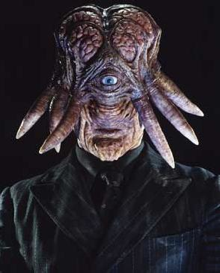
[Dalek Sec before he became encased in his mechanical body]
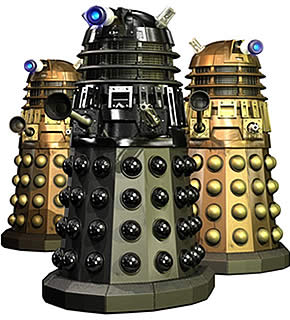
[One eyed Daleks with their glowing eye]

